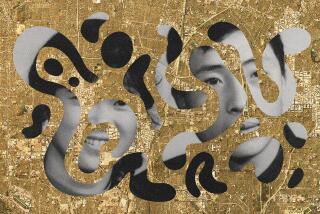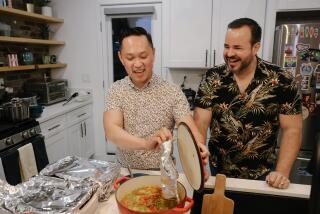Virgin Mary a Link for Filipinos
As the candles were lighted, the faces of the mostly elderly people who were crowded in front of the image of the Blessed Virgin Mary appeared to take on a solemn glow. The leader, with rosary beads in the fingers of one hand, intoned the litany to the Virgin Mary as the rest responded: âPray for us.â
With the rosary over, Teresita Quintos of Fullerton, the owner of the house, took the statue from the small altar and then led a procession to a community center nearby, where more prayers were said. A Catholic priest, Msgr. Magdaleno Latoja, who was visiting from the Philippines, read the Bible and performed a short homily.
Then, the candles were blown out--and the party began.
In a rite as old as Christianity in the Philippines, Filipino-Americans in Orange County move the image of the Virgin Mary each week from one household to another. They recite the rosary and later have a feast while swapping stories about whatâs happening back home.
Itâs a strange mix of the religious and social but it serves as a cultural link among the estimated 30,000 Filipino-Americans who call the county home.
Last week, Teresita and Armando Quintos welcomed about 30 Filipino-Americans to their home for the religious ceremony that coincided with Teresita Quintosâ 49th birthday.
âItâs not uncommon for Filipinos to combine religion with socials,â said Father Marito Ribamontan, Filipino parish priest of Anaheimâs St. Anthony parish. âItâs a legacy from the Spaniards.
The Spaniards brought Christianity to the Philippines in the 16th Century. Ribamontan said the rosary became popular there after its powers were credited with turning back the Dutch, who tried to invade the islands in the 1700s.
Devotion to the Virgin Mary is particularly special to Filipinos because âmothers occupy a special place in our culture,â he said.
For Filipinos in the United States, Father Ribamontan said the rosary is also a reminder of how the Holy Family was turned away from one inn after another at the time of Christâs birth and subsequent travels. âFilipinos find similarities with their lives here (as immigrants) in America,â he said.
In Orange County, as many as 2,000 Filipino-Americans are active in the rosary devotion, Ribamontan said. Bishop Norman McFarland of Orange started the devotion several years ago by forming the Filipino Rosary Catholic Federation, he said.
However, many Filipino rosary groups are set up just to bring the image of the Virgin Mary to their homes and are not affiliated with the federation. The most popular images are those of the Lady of Fatima, the Lady of Lourdes and the Nativity. Some groups carry the image of the Child Jesus, or the Santo Nino, the patron saint of Manila.
Madeleine Solidon, who belongs to a Cerritos group, said schedules for the rosary processions are set up at the start of the year; special occasions such as birthdays are arranged in advance.
There is concern, however, that the devotion may die along with first generation Filipino-Americans; younger Filipino-Americans are not as interested as their elders.
âWeâre so wrapped up in our own lives and so influenced by Western culture,â said Mariciel Quintos, Teresita Quintosâ daughter. âItâs not our priority to do this. Itâs like an extracurricular activity and kids would rather have their own extracurricular activities.â
A graduate student at Cal State Fullerton, Mariciel Quintos, 26, agreed that unless new Filipino immigrants come to the United States, the tradition âwill dwindle down.â
Jessie Solidon, a Cerritos veterinarian, said that Filipinos will always come to America and that, because of this, the rosary devotion will not die. Parents can help preserve the rite, too, he said.
âThe bottom line is, itâs family upbringing. Itâs up to the individual Filipino families to encourage their children,â Solidon said.
More to Read
Sign up for Essential California
The most important California stories and recommendations in your inbox every morning.
You may occasionally receive promotional content from the Los Angeles Times.










